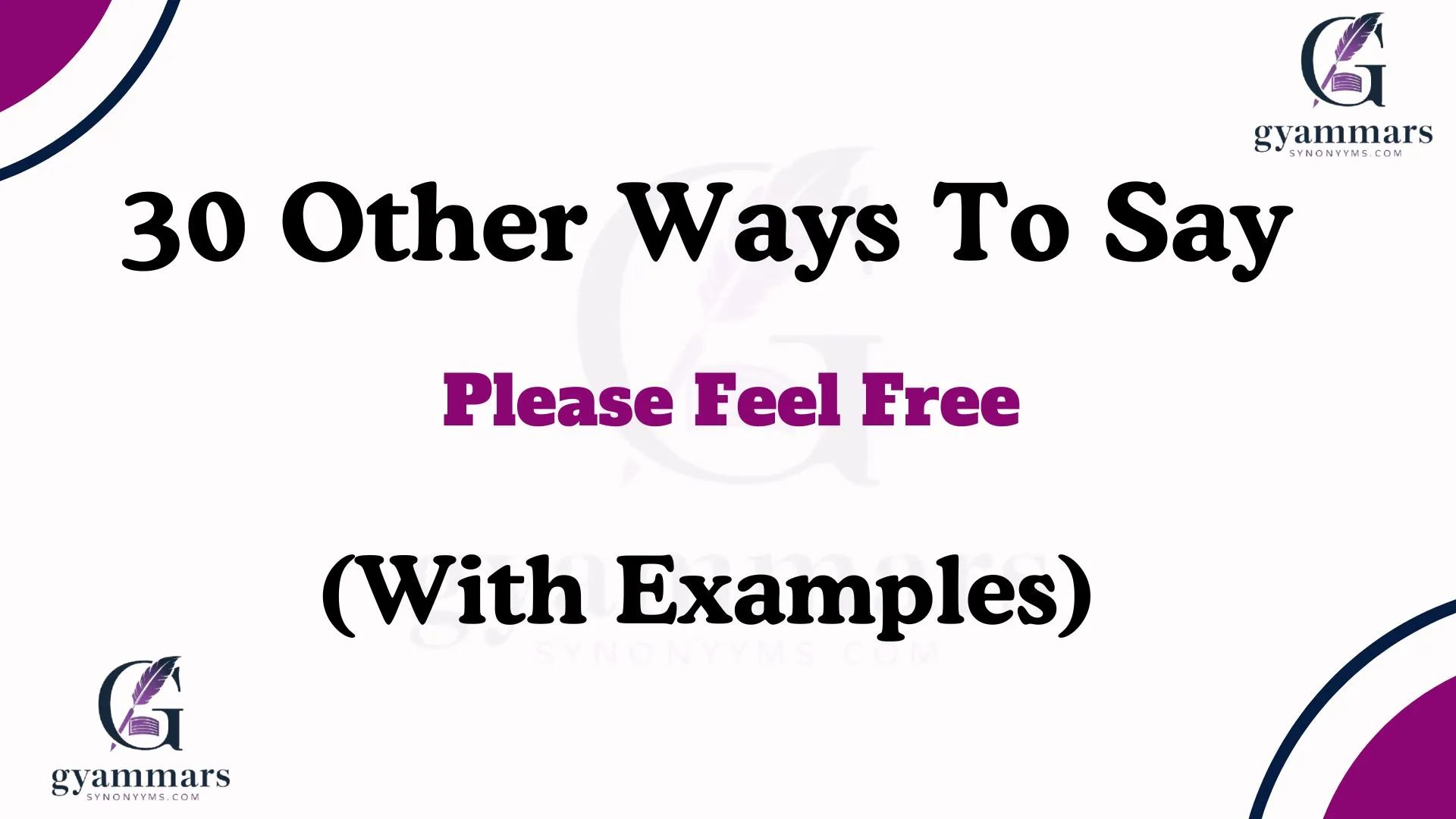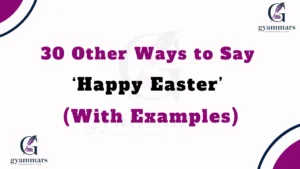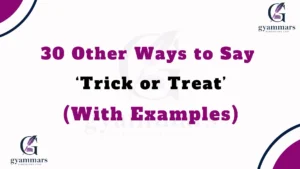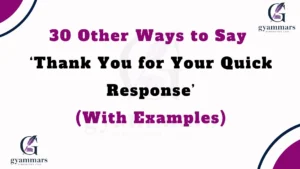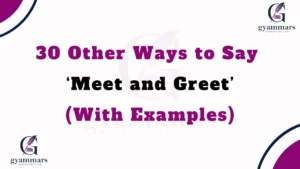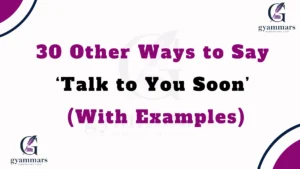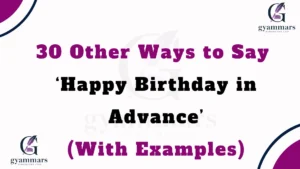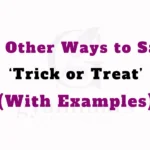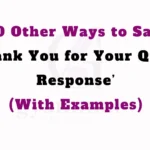Effective communication goes beyond just the words we use; it’s about conveying warmth, care, and empathy. One phrase that often appears in emails, conversations, and invitations is “please feel free,” which can sometimes sound a bit overused or impersonal. That’s why finding thoughtful alternatives to express the same sentiment is essential.
By using more nuanced phrases, you can make your message sound more personal and meaningful. Below, we’ll explore 30 ways to say “please feel free,” along with examples, definitions, and tones that will help you communicate more effectively and with kindness.
What Does “Please Feel Free” Mean?
“Please feel free” is a polite way of encouraging someone to take action without hesitation or pressure. It suggests openness and ease, inviting the other person to act as they wish or need. It’s commonly used in both professional and casual contexts, signaling permission or encouragement to engage in an action, ask questions, or make decisions.
Is It Professional/Polite to Say “Please Feel Free”?
Yes, “please feel free” is generally professional and polite. It’s widely used in both formal and informal contexts, such as in customer service, emails, or during conversations to give someone the confidence to act. However, depending on the situation, you might find other alternatives that sound more specific or intentional.
Pros and Cons of Saying “Please Feel Free”
Pros:
- It’s a polite, friendly phrase that creates a comfortable atmosphere.
- It’s versatile and can be used in various contexts, from professional to casual conversations.
- It helps convey openness and accessibility.
Cons:
- It can sometimes sound overused or less personal.
- It may feel too vague if not backed up with context or specific encouragement.
Synonyms For Please Feel Free
- Don’t Hesitate to
- Feel Welcome to
- You’re Encouraged to
- Go Ahead and
- It’s All Right to
- Feel at Ease to
- I Invite You to
- You Are More Than Welcome to
- I Encourage You to
- Feel Free to Reach Out
- You’re More Than Welcome to
- I’d Be Happy If You
- You Have My Permission to
- You Are Free to
- By All Means
- Go Ahead and Take
- Feel Free to Let Me Know
- Please Don’t Hesitate to
- Please Feel Open to
- I’m Here If You Need
- You Are Invited to
- Take the Opportunity to
- Feel Comfortable to
- You Are Welcome to
- Feel at Liberty to
- Please Don’t Be Afraid to
- Feel Free to Ask
- It’s Okay to
- Feel Free to Proceed
- You’re Invited to
1. “Don’t Hesitate to”
Definition: This phrase encourages action without delay, conveying a sense of urgency or ease in doing something.
Detailed Explanation: “Don’t hesitate to” invites others to act quickly and confidently. It creates a sense of urgency but still maintains politeness.
Scenario Example: “If you have any questions, don’t hesitate to reach out.”
Best Use: When you want to convey that someone should take action right away, but with encouragement.
Tone: Supportive, warm, polite
Additional Notes: Use in professional or customer service settings for a prompt response.
2. “Feel Welcome to”
Definition: A warm and inviting phrase that encourages someone to do something comfortably.
Detailed Explanation: It’s a way of making someone feel invited and assured that their actions will be welcomed.
Scenario Example: “Feel welcome to contact me if you need any assistance.”
Best Use: In casual or customer service settings to make someone feel at ease.
Tone: Inviting, friendly
Additional Notes: Works well when creating a warm and welcoming environment.
3. “You’re Encouraged to”
Definition: This is a more formal alternative that suggests someone is invited or supported to take action.
Detailed Explanation: “You’re encouraged to” provides a sense of permission and support to proceed with an action or request.
Scenario Example: “You’re encouraged to speak up if you have any ideas.”
Best Use: In professional settings where you want to empower someone to act.
Tone: Empowering, polite
Additional Notes: Excellent for team environments or during meetings to prompt contributions.
4. “Go Ahead and”
Definition: A casual and supportive phrase that gives permission to proceed.
Detailed Explanation: “Go ahead and” is often used when giving someone a green light to do something, making the action feel natural and effortless.
Scenario Example: “Go ahead and send the report when you’re ready.”
Best Use: In casual or informal conversations when you’re comfortable with the action being taken.
Tone: Casual, supportive
Additional Notes: Best used in informal settings or when there is a friendly relationship.
5. “It’s All Right to”
Definition: A reassurance that it is acceptable to proceed with an action or decision.
Detailed Explanation: “It’s all right to” offers comfort by confirming that the action is okay, alleviating any concerns or hesitation.
Scenario Example: “It’s all right to take the rest of the day off if you need it.”
Best Use: When offering permission or encouraging rest or personal time.
Tone: Reassuring, comforting
Additional Notes: Great in work environments to express understanding and flexibility.
6. “Feel at Ease to”
Definition: A phrase that conveys comfort and encourages action without worry.
Detailed Explanation: “Feel at ease to” emphasizes that taking the action is completely comfortable and allowed.
Scenario Example: “Feel at ease to ask me anything about the project.”
Best Use: In environments where openness and trust are important.
Tone: Comfortable, inviting
Additional Notes: Use to encourage participation in a safe and trusting environment.
7. “I Invite You to”
Definition: A formal way of encouraging someone to take part in an action or event.
Detailed Explanation: “I invite you to” extends an open invitation to someone to take part or make a decision. It’s both polite and formal.
Scenario Example: “I invite you to join the discussion at any point.”
Best Use: Formal or professional settings to offer an invitation to participate.
Tone: Formal, polite
Additional Notes: Suitable for official or formal invitations, whether in person or via email.
8. “You Are More Than Welcome to”
Definition: A phrase that gives someone a generous and heartfelt invitation to take action.
Detailed Explanation: This expression emphasizes warmth and openness, ensuring the person feels truly invited to act.
Scenario Example: “You are more than welcome to ask any questions during the session.”
Best Use: In both formal and informal settings, especially when you want to express a generous and welcoming invitation.
Tone: Warm, generous
Additional Notes: Best used in customer service or team environments.
9. “I Encourage You to”
Definition: A supportive way to ask someone to take action, often to reassure them they are making the right choice.
Detailed Explanation: “I encourage you to” is empowering and shows confidence in the person’s abilities or decisions.
Scenario Example: “I encourage you to take the lead on this project.”
Best Use: When you want to inspire confidence and action in someone.
Tone: Empowering, supportive
Additional Notes: Excellent for leadership or coaching contexts.
Read More: 30 Other Ways to Say “Get Well Soon” (With Examples)
10. “Feel Free to Reach Out”
Definition: A casual, encouraging way to let someone know they are welcome to contact you.
Detailed Explanation: This is a friendly invitation to connect, whether for questions or assistance.
Scenario Example: “Feel free to reach out if you need more information.”
Best Use: In emails, messages, or conversations where you want to offer support.
Tone: Friendly, approachable
11. “You’re More Than Welcome to”
Definition: A phrase expressing genuine openness and encouragement for someone to take action.
Detailed Explanation: This expression goes beyond a simple invitation, emphasizing that the person is genuinely welcome to act without hesitation.
Scenario Example: “You’re more than welcome to share your thoughts during the meeting.”
Best Use: When you want to express warmth and generosity, both in professional and personal contexts.
Tone: Warm, inviting
Additional Notes: This phrase can be used in both formal and informal settings to encourage participation.
12. “I’d Be Happy If You”
Definition: A phrase that communicates genuine happiness for the person’s action, making it sound welcoming and encouraging.
Detailed Explanation: This phrase conveys enthusiasm and reassurance, showing that the speaker is genuinely supportive of the action.
Scenario Example: “I’d be happy if you reached out with any questions.”
Best Use: In professional settings, especially when offering help or support.
Tone: Friendly, supportive
Additional Notes: Works well when trying to make someone feel more comfortable and positive about reaching out.
13. “You Have My Permission to”
Definition: A straightforward way of giving someone the freedom or authority to take action.
Detailed Explanation: This phrase is more formal and gives explicit permission to the other person, often used in professional or legal contexts.
Scenario Example: “You have my permission to use the materials for your presentation.”
Best Use: In formal environments or when clear permission is needed.
Tone: Authoritative, clear
Additional Notes: Ideal for settings that require formal authorization or when someone seeks confirmation.
14. “You Are Free to”
Definition: A simple and direct way to give someone the freedom to take action, without pressure or constraints.
Detailed Explanation: “You are free to” is a calm, relaxed way of offering permission, emphasizing that the person has full freedom to proceed.
Scenario Example: “You are free to decide on your schedule for the project.”
Best Use: In casual work settings or any environment where autonomy is encouraged.
Tone: Relaxed, empowering
Additional Notes: This phrase conveys autonomy and encourages independent decision-making.
15. “By All Means”
Definition: A phrase used to give someone enthusiastic permission or encouragement to proceed.
Detailed Explanation: This expression conveys eagerness and positivity, suggesting that someone should feel confident and encouraged to act.
Scenario Example: “By all means, ask if you need any help!”
Best Use: In informal settings when you want to show excitement or eagerness to help.
Tone: Enthusiastic, encouraging
Additional Notes: Best used in informal settings, where enthusiasm and positivity are encouraged.
16. “Go Ahead and Take”
Definition: A simple and casual way of giving someone permission to proceed.
Detailed Explanation: “Go ahead and take” is a clear and easygoing phrase that implies permission to take an action without hesitation.
Scenario Example: “Go ahead and take the afternoon off if you need to.”
Best Use: In situations where you want to make someone feel comfortable in making a decision.
Tone: Casual, relaxed
Additional Notes: Often used in informal work settings or between colleagues or friends.
17. “Feel Free to Let Me Know”
Definition: A polite and approachable way to invite someone to communicate or ask for help.
Detailed Explanation: This is an invitation for someone to reach out or share their thoughts, making them feel open and comfortable in doing so.
Scenario Example: “Feel free to let me know if you need anything.”
Best Use: In professional or customer service situations when you want to convey accessibility.
Tone: Approachable, polite
Additional Notes: Frequently used in customer service or emails to maintain open communication.
18. “Please Don’t Hesitate to”
Definition: A polite and formal way to encourage someone to act without reservation.
Detailed Explanation: This phrase reassures someone that it’s okay to act or ask questions without fear of judgment or inconvenience.
Scenario Example: “Please don’t hesitate to contact me if you have any further inquiries.”
Best Use: In formal emails or professional settings when you want to encourage communication.
Tone: Formal, reassuring
Additional Notes: Ideal for customer service or when maintaining a professional and welcoming tone is important.
19. “Please Feel Open to”
Definition: A phrase that invites someone to take action without any pressure or reluctance.
Detailed Explanation: “Please feel open to” is another gentle, polite way to offer permission or encourage action.
Scenario Example: “Please feel open to suggest any improvements to the project.”
Best Use: In meetings, discussions, or collaborative environments where feedback is encouraged.
Tone: Gentle, encouraging
Additional Notes: Suitable for environments where mutual respect and openness are key values.
20. “I’m Here If You Need”
Definition: A phrase that reassures someone that help or support is available should they choose to reach out.
Detailed Explanation: This phrase offers support, ensuring the other person feels that they can rely on you if needed.
Scenario Example: “I’m here if you need any help with the presentation.”
Best Use: In supportive or mentoring situations where you want to offer help without imposing.
Tone: Supportive, reassuring
Additional Notes: Works well when you want to make someone feel comfortable asking for help.
21. “You Are Invited to”
Definition: A formal or professional way of offering someone the opportunity to take part in something.
Detailed Explanation: This expression invites someone to participate or act, typically in an event or opportunity.
Scenario Example: “You are invited to submit your feedback on the proposal.”
Best Use: In formal invitations, whether to meetings, events, or tasks.
Tone: Formal, polite
Additional Notes: Ideal for professional settings, especially when organizing events or seeking contributions.
22. “Take the Opportunity to”
Definition: A phrase that encourages someone to act by seizing the moment.
Detailed Explanation: This phrase suggests that it is a good time to take action, whether it’s asking questions or making decisions.
Scenario Example: “Take the opportunity to ask questions during the Q&A session.”
Best Use: When you want someone to act confidently, usually in a situation where they might hesitate.
Tone: Encouraging, motivational
Additional Notes: Best for meetings or public speaking scenarios where individuals can be hesitant.
23. “Feel Comfortable to”
Definition: A comforting invitation that ensures someone knows they are welcome to act or ask without pressure.
Detailed Explanation: This phrase aims to put the person at ease, making them feel safe and unburdened by any pressure.
Scenario Example: “Feel comfortable to voice your opinion if you have any suggestions.”
Best Use: When you want to create a welcoming atmosphere, especially in a group or discussion setting.
Tone: Relaxed, reassuring
Additional Notes: Suitable for group settings or environments that value openness and honesty.
24. “You Are Welcome to”
Definition: A clear, friendly phrase offering permission or encouragement.
Detailed Explanation: This phrase provides an open invitation to take an action, ensuring the person knows they have permission to proceed.
Scenario Example: “You are welcome to attend the team meeting tomorrow.”
Best Use: In both formal and informal settings when offering an open invitation.
Tone: Friendly, polite
Additional Notes: A versatile phrase that can be used in various contexts.
25. “Feel at Liberty to”
Definition: A slightly more formal phrase suggesting that someone is free to act according to their own discretion.
Detailed Explanation: “Feel at liberty to” conveys a more formal tone while still offering freedom and encouragement to take action.
Scenario Example: “Feel at liberty to call me if you need clarification on any points.”
Best Use: When you want to maintain professionalism while still encouraging someone to take action.
Tone: Formal, polite
Additional Notes: Suitable for formal emails or workplace communications.
26. “Please Don’t Be Afraid to”
Definition: A phrase that encourages someone to take action without fear of judgment or consequences.
Detailed Explanation: This expression gently reassures someone that it’s okay to proceed, even if they feel nervous or hesitant.
Scenario Example: “Please don’t be afraid to speak up if you have any ideas.”
Best Use: In professional settings where someone might be hesitant to contribute or ask questions.
Tone: Reassuring, encouraging
Additional Notes: Useful in a mentoring or coaching context.
27. “Feel Free to Ask”
Definition: A common phrase used to let someone know they are welcome to inquire or request help without hesitation.
Detailed Explanation: This phrase emphasizes openness and accessibility, showing that asking questions is encouraged.
Scenario Example: “Feel free to ask for clarification at any time.”
Best Use: Ideal for situations where you want to maintain open communication, especially in customer service or educational settings.
Tone: Friendly, approachable
Additional Notes: Often used in email communications or discussions where support is needed.
28. “It’s Okay to”
Definition: A simple phrase that gives someone permission to take action or make a decision without worry.
Detailed Explanation: “It’s okay to” reassures someone that their action is acceptable and encouraged.
Scenario Example: “It’s okay to take a break if you need to.”
Best Use: When you want to offer a sense of ease, especially when discussing flexible situations.
Tone: Reassuring, casual
Additional Notes: Great for informal settings where relaxation or taking time off is involved.
29. “Feel Free to Proceed”
Definition: A polite, formal way of letting someone know they are welcome to move forward with their plans or actions.
Detailed Explanation: This phrase is often used when giving someone permission to continue with a task or project.
Scenario Example: “Feel free to proceed with the next steps in the process.”
Best Use: When encouraging someone to continue working or to move forward with a plan.
Tone: Formal, professional
Additional Notes: Works well in project management or formal work-related settings.
30. “You’re Invited to”
Definition: A formal phrase offering someone the opportunity to engage in an activity or decision.
Detailed Explanation: “You’re invited to” conveys a polite invitation to act, often used in professional settings.
Scenario Example: “You’re invited to participate in the upcoming team workshop.”
Best Use: In official or formal invitations, whether in meetings, events, or activities.
Tone: Formal, polite
Additional Notes: Ideal for when you need to make someone feel formally invited to participate in something.
Conclusion
In communication, especially when encouraging others to take action or ask questions, using thoughtful alternatives to phrases like “please feel free” can make a world of difference. By choosing the right words, you can convey warmth, respect, and openness, making the recipient feel valued and comfortable.
Whether you’re in a professional, casual, or supportive environment, these 30 alternatives offer a range of options that allow you to express care and invitation in ways that are personal and meaningful.
As you continue to enhance your communication, keep in mind that tone, context, and intent play a significant role in ensuring your message resonates with others. Use these alternatives thoughtfully, and you’ll build stronger, more empathetic connections.
FAQs
1. What does “please feel free” mean?
“Please feel free” is an invitation or permission to take action, ask questions, or make decisions without hesitation. It conveys openness and encourages someone to proceed comfortably.
2. When should I use alternatives to “please feel free”?
You can use these alternatives in both formal and informal contexts, especially when you want to add a personal touch, provide reassurance, or make your invitation sound more specific and thoughtful.
3. Are these alternatives formal or casual?
These alternatives cover a wide range, from formal phrases like “You have my permission to” to casual ones like “Go ahead and.” Depending on the tone you wish to convey and the setting, you can choose accordingly.
4. How can I make sure I’m using the right alternative?
Consider the context and the relationship with the person you’re addressing. For example, use more formal alternatives like “Please don’t hesitate to” in professional settings, and casual phrases like “Go ahead and” in informal conversations with colleagues or friends.
5. Can I use these alternatives in emails?
Absolutely! These alternatives work great in emails, whether in professional settings or casual conversations. You can choose the phrase that fits the tone of your email, creating a more approachable and considerate message.

“Emma Brooke at Grammar Synonyms is your trusted source for mastering the art of language. Whether you’re looking for the perfect synonym, refining your grammar, or searching for that one ideal phrase, we’ve got you covered. With a wealth of tools and resources, Emma Brooke brings you creative solutions for all your writing needs, making sure your words always hit the mark. Unlock a world of language possibilities and elevate your writing with ease.”
